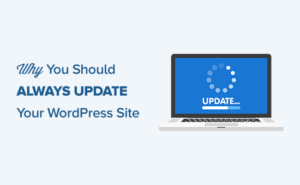Every time a replacement WordPress update comes out, we get several emails from users asking whether it’s safe to update their WordPress site. Are you wondering whether you ought to update your WordPress to the newest version? Want to understand the pros and cons of updating WordPress?
Table of Contents
In this article, we will explain why it is crucial that you always use the latest version of WordPress as well as show you how to properly update WordPress.

WordPress is free, and it’s developed by a community of developers. With each new release, they fix bugs, add new features, improve performance, and enhance existing features to remain up so far with new industry standards.
So in other words, once you don’t update your WordPress site, you’re risking your website security and missing out on new features / improvements
use the latest version of WordPress #1. Security
Security is arguably the foremost important reason why you ought to keep your WordPress website up so far .
WordPress powers more than 60% of all websites in the world. Due to its popularity, WordPress may be a common target for hackers, malicious code distributors, data thieves, and hackers.

Since WordPress is open source, anyone can study the ASCII text file to find out and improve it. However it also means hackers can study it too and find ways to interrupt into websites.
Now the great part is that not all hackers are bad. There are tons more good hackers than bad ones which suggests that security experts round the world can study the code and properly report security bugs / fixes. Every time a security vulnerability is reported, the core WordPress team works diligently to release an update that fixes the difficulty .
This means that if you’re not using the newest version of WordPress, then you’re using software with known security vulnerabilities. Hackers can look for websites running the older version, and you’ll become a victim of a classy attack.
Not just WordPress itself, plugins also can be exploited by hackers. You need to form sure that each one your WordPress plugins, themes, and therefore the core itself is usually up so far .
For more recommendations on keeping your site secure, see our ultimate guide to WordPress security.
#2. Cool New Features
Each major WordPress release comes with new features and changes to the software. For example, WordPress 5.0 introduced the block editor, WordPress 5.3 included accessibility and UI improvements, and WordPress 5.4 came with new blocks and enhancements to the block editor.

Now if you were using an older version of WordPress, then your WordPress experience would be tons different than someone using the foremost recent version.
You will have trouble finding WordPress help online because you’re using an older version. Users on WordPress support forums will assume that you simply simply are using the most recent version of WordPress.
3. Speed

WordPress developers are always trying to form things faster. Each new release comes with several performance improvements that creates WordPress run faster and more efficient.
For example, WordPress 4.2 improved JS performance for navigation menus, and WordPress 4.1 improved complex queries which helped with performance of websites using those queries.
Since speed may be a huge think about SEO, you ought to definitely keep your WordPress updated to make sure maximum performance benefits.
For more tips on boosting your site speed, check out our ultimate guide to WordPress speed and performance.
4. Bug Fixes
Despite the rigorous testing of major releases, sometimes WordPress bugs may slip through the cracks. That’s why there are timely minor WordPress releases (the ones with X.X.X) to account for that. for instance , the foremost recent WordPress 4.2.3 update fixed 20 bugs from the 4.2 release.
Now if you attend WordPress support forums asking for help, the first advice you will get is to update WordPress because which can fix the problem . If you enforce not updating WordPress, then you will be unable to receive help.
5. Compatibility (or NOT)
Despite the rigorous testing of major releases, sometimes WordPress bugs may slip through the cracks. That’s why there are timely minor WordPress releases (the ones with X.X.X) to account for that. for instance , the foremost recent WordPress 4.2.3 update fixed 20 bugs from the 4.2 release.
Now if you attend WordPress support forums asking for help, the first advice you will get is to update WordPress because which can fix the problem . If you enforce not updating WordPress, then you’ll be unable to receive help.
This is why it is crucial that you keep regular WordPress backups.
To sum this up, the sole downside is that in some rare cases your site will break. However the upside is that you have:
- Improved WordPress security
- Cool new WordPress features
- Faster WordPress experience
- A bug free WordPress website
- Better compatibility
Now that you simply know why it’s important to stay your WordPress site updated, let’s take a glance at the way to update WordPress.
How to Keep Your WordPress Site Updated
Updating your WordPress core, plugins, and themes whenever there’s a replacement update for them is fairly easy. WordPress comes with a built-in update notification system. It highlights the amount of obtainable updates once you log into your WordPress dashboard.

All you would like to try to to is visit Dashboard » Updates page and install those updates. This is a one-click process.
However since many website owners don’t login to their WordPress dashboard daily, they’ll not even know that there’s an update available for days. Thankfully, you have a few options.
If you’re using WordPress 3.7 or above, then automatic updates are turned on for minor releases (which are reserved for security and bugfixes). You can activate automatic updates for major releases, plugins also as themes.
Alternatively, you’ll get email notifications when there’s a replacement update for your WordPress site.
Get Email Notifications for Updates in WordPress
When you’re busy running your business, logging into your site to see for updates is typically the last item on your mind. Wouldn’t it’s easier if you’ll get an email notification whenever there’s an update on your WordPress sites?
Well that’s possible.
First thing you would like to try to to is install and activate the WP Updates Notifier plugin. Upon activation, visit Settings » Updates Notifier to configure the plugin settings.

This plugin uses WordPress cron to see your site for updates every hour. You can change that to once or twice daily. When there is a replacement update available, this plugin will send you an email notification.
By default it checks for WordPress core update, plugin updates, and theme updates. All you would like to try to to is click on save settings with test email button.
If you are doing not recieve the test email from the plugin, then inspect our guide the way to fix WordPress not sending email issue.
Auto Install WordPress Updates
You can automate the process even further. WordPress allows you to enable automatic updates for major releases, plugins, and themes.
This option is risky if you’re not using managed WordPress hosting. Managed WordPress hosting companies automatically update your site to major WordPress versions and keep an eye fixed fixed out if something breaks.
If you switch on automatic updates, then there’s a small risk that your site may break and you won’t be online to repair it directly . Having that said, if you wish to enable automatic updates, then there are two ways to try to to it (plugin method and code method).
Let’s take a glance at the plugin method first.
First you would like to put in and activate the straightforward Updates Manager plugin. Upon activation, you would like to go to Dashboard » Update Options page to configure the plugin.

Now you would like to scroll right down to automatic updates section where you’ll enable automatic updates for core, plugins, themes, and translation files. Once you are done, simply save your settings.
Enable Auto Updates Using wp-config File
You can enable automatic updates for WordPress core by simply adding this line to your wp-config.php file.
Make sure to backup your site first, just in case anything goes wrong.
- define(‘WP_AUTO_UPDATE_CORE’, true);
If you furthermore may want to automatically update your themes and plugins, then you’d got to add this to your theme’s functions.php file or a site specific plugin.
|
1
2
|
add_filter( 'auto_update_plugin', '__return_true' );add_filter( 'auto_update_theme', '__return_true' ); |
We hope this text helped you learn why you ought to always use the newest version of WordPress. You may also want to see out our expert pick of must have WordPress plugins.


